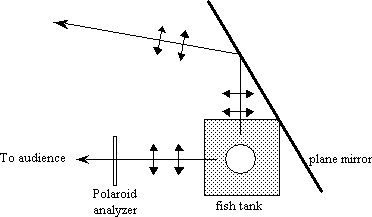Simulation of atmospheric scattering and polarization of sunlight using slide projector and aquarium containing milky water.
Video of our demo in action https://youtu.be/y0dhFCsKomk
What it shows:
Unpolarized light passing through a fluid is scattered; the scattered light being partially or completely plane polarized. For scattering by particles of comparable size to the wavelength of the light, this process is called Rayleigh scattering. The wavelength dependence of this type of scattering is responsible for blue skies and red sunsets.
How it works:
Unpolarized white light from a slide projector enters a fish tank of very slightly milky water. Some of the electromagnetic waves impinge on the colloidal particles and molecules in the water, are absorbed and re-radiated. The horizontal component (say) of the polarization decreases as cos2θ, where θ is the scattering angle (figure 1) The maximum scattered intensity is perpendicular to the plane of oscillation of the molecule, where it is also totally plane polarized, θ=90°. At other angles the light is partially plane polarized.
figure 1. Polarization by scattering
To show this, the audience observes the tank at right angles to the initial direction of propagation of the light. A mirror angled over the tank allows them to see scattered light emerging from two surfaces perpendicular to each other (see figure 2). By placing a Polaroid sheet between the projector and the tank with its polarizing axis horizontally, the scattered light from the side of the fish tank is blocked, whereas that from the top of the tank remains unaffected. Rotating the Polaroid 90° blocks the light from the top of the tank, but now the scattered light from the side of the tank reappears. Alternatively, let the scattering process polarize an unpolarized beam from the slide projector and let the Polaroid sheet be the analyzer (shown in figure 2).
Rayleigh scattering has a wavelength dependence of 1/(λ4), so it affects blue light much more strongly than red. By adding milk to the tank, you increase the scattering; the milky water begins to develop a bluish tint and the unscattered beam reddish.
figure 2. Fish tank and mirror arrangement, looking into the beam.
Setting it up:
The action takes place in a 5 gallon fish tank. The mirror, 1m × 0.75m, is hinged and its base can be clamped to a cart; the mirror then leans on the tank. The mirror should be angled to give the center rows of the audience the optimum view of the upper surface of the tank; this puts it at over 45° and unfortunately the view is not perfect for the front and back of the hall. Provide a beaker of milk and a pipette to add milk to the tank. The water may be dirty enough initially to scatter well without adding milk. For a slide projector use a Besseler Slide King as it has a powerful 1000W bulb, and load it with a 5cm circular aperture slide to simulate the Sun. It can sit on the cart too, but leave a small distance between it and the tank so you can insert the Polaroid. The unscattered light should fall onto a projection screen several meters ahead of the cart, angled so that the audience can see the spot.
Comments:
Be careful not to add too much milk, as multiple scattering will occur and wash out the color effect as well as the polarization. The λ-4 dependence is only valid if the scattering objects are smaller or comparable in size to the wavelength of the light. So it works for nitrogen and oxygen molecules, but not for water droplets which are much larger than λ and scatter all colors equally, hence clouds are white.